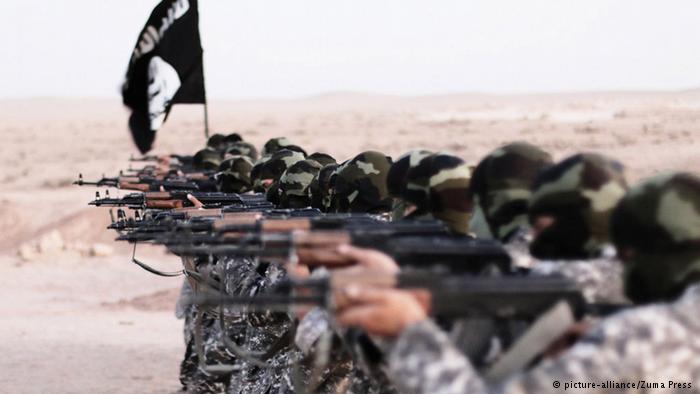 Most people immediately think about the Mideast or North Africa when they hear the name "Islamic State." But the terror militia also has an eye on the former Soviet republics in Central Asia.
Most people immediately think about the Mideast or North Africa when they hear the name "Islamic State." But the terror militia also has an eye on the former Soviet republics in Central Asia.
Regional media reported that it was an "unprecedented" operation: In mid-March, equipped with heavy military equipment, about 45,000 Tajik soldiers and 2,000 Russian troops joined forces in a military exercise, practicing methods of defense against foreign terrorists.
The last part of the exercise was held in the south of the former Soviet republic of Tajikistan, about 15 kilometers (9.3 miles) from the Afghan border. It was a message obviously aimed both at the Taliban and at fighters affiliated with the "Islamic State" (IS) terror militia.
For months, Russia has been carefully watching the IS inch closer to Central Asia. The danger of Islamists using Afghanistan as their springboard to the region is becoming more concrete, a Russian foreign ministry spokeswoman warned at the end of last year. Tajikistan, Uzbekistan, Turkmenistan, Kyrgyzstan and Kazakhstan - Moscow regards these states as belonging to its sphere of influence. Russia also sees a threat to its southern flank, so it supports them in the framework of the Collective Security Organization Treaty (CSTO) military alliance.
Number of fighters on the rise
There is no reliable data on IS fighters from Central Asia in Syria and Iraq. In December 2015, the New York-based Soufan Group estimated at 4,700 the number of IS members from the former Soviet Union. About 2,400 of those are Russian citizens, mainly from the northern Caucasus region, the group says, adding that their number tripled in just a year. About 2,000 IS fighters are thought to be from Central Asia - and their numbers, too, are on the rise. While the Soufan Group says that 500 fighters are from Uzbekistan and Kyrgyzstan respectively, other sources quote even higher figures.
Despite all the uncertainty over numbers, "those are tiny fractions from the Muslim communities - but still big enough to challenge security policies," says Uwe Halbach of the German Institute for International and Security Affairs (SWP) in Berlin. In addition, Halbach told DW, the IS' ties to the post-Soviet areas in Russia's northern Caucasus are closer than those to Central Asia.
Experts disagree whether the majority of the Central Asian IS fighters came to the group directly from their native countries or from Russia, Halbach says. "Some Tajik migrants to Syria are part of the Tajik diaspora that is increasingly under pressure in Russia." Over the past few years, he adds, Russian policies toward migrant laborers from Central Asia have been increasingly restrictive.
Authoritarian states, impoverished citizens
All the same, Central Asia, with a population of almost 70 million people, seems to be an attractive recruiting area for the IS. Authoritarian regimes that are among the world's most corrupt have for decades ruled the five former Soviet republics, and large parts of the mainly Muslim population have lived in poverty since the collapse of the Soviet Union.
Young people in particular are vulnerable to the IS' ideas, Akezhan Kazhegeldin warns. "If the young people don't see prospects for themselves, and aren't free to change the system, they'll start listening to extremist politicians," the former prime minister of Kazakhstan told DW. The Islamists' plan of a cross-border "caliphate" is popular among the young, he adds.
The IS really does score in Central Asia with the topic of "a more just society for Muslims," Halbach agrees.
Alarm bells in Tajikistan
The number of IS supporters has risen to such a degree that alarm bells are ringing in states like Tajikistan, Halbach says, adding that the country with its more than 1,300-kilometer-long border with Afghanistan is regarded as particularly vulnerable to the IS.
In May 2015, Colonel Gulmurod Khalimow, a senior Tajik police commander, defected to the IS. The move prompted the government to step up its rhetoric concerning the "threat from the outside," Halbach says, adding that the country's elite uses "the same argument to deflect from its own shortcomings."
The controversial ban of the Islamic Renaissance Party of Tajikistan in September 2015 is an example of the country's domestic problems, says Halbach. The Supreme Court accused the only Muslim party in the post-Soviet region of preparing a coup. With that decision, Tajikistan "cancelled the consensus that opposition parties need to be integrated," the Berlin analyst says.
The banned party's leader, Muhiddin Kabiri, now lives in exile in Europe. The government long worked toward the goal of having only two powers in the country: the ruling party and radical youth, the opposition politician says. "If the IS is defeated or weakened in the Mideast, it would have to move on, and that would be a danger for Tajikistan," Kabiri says, and accuses the country of "playing with fire."
IS attack in Afghanistan unlikely
It's unlikely that the IS will attack the Central Asian republics directly, the experts say. There are only small groups of IS supporters in Afghanistan, according to Kosimsho Iskandarov, the head of the Center for Afghanistan Studies in the Tajik capital, Dushanbe.
The Berlin-based Federal Academy for Security Policy (BAKS) agrees. "Unlike in Syria and Iraq, a massive IS military invasion in Central Asia is unlikely at present," the academy wrote in a working paper last month, adding that the IS will, however, presumably try to spread in the region, step by step. To prevent that, the BAKS says, moderate Muslim forces must be allowed to participate in politics.
DW, 29.03.2016




